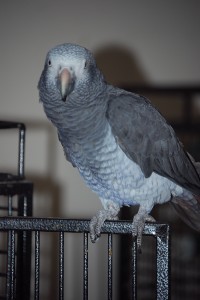parrot trainint
My Thoughts On Taming A Pet Parrot
NOTE: I have a new pet behavior blog located at http://www.SoMuchPETential.com/blog. Thanks!
(one of my past Hyde Park Living columns)
Alright, I’ve got to speak my mind this month. I have heard so many people and seen so many web sites talking about ‘taming’ birds.
 Knowing what I know about behavior and being as compassionate as I am about other living beings, I hate that phrase. It makes me cringe actually because taming to me infers dominance and force. And dominance and force in no way helps build a relationship of trust and foster quality of life.
Knowing what I know about behavior and being as compassionate as I am about other living beings, I hate that phrase. It makes me cringe actually because taming to me infers dominance and force. And dominance and force in no way helps build a relationship of trust and foster quality of life.
Let me share some excerpts of ‘taming’ tactics suggested on web sites.
“If you make a fist and bend your wrist as far as it will go, you’ll notice that the skin on the back of the fist becomes very tight. Bring your fist up to the bird very slowly, finding out where its striking range is….The Fist, brought slowly toward the bird’s beak, can be used to control the bird, move it away from you, hold it off and let it know that you are not about to be driven out of the territory.”
“If your bird is so aggressive that you cannot safely place your hand inside its cage, try wearing thick oven mitts on your hands. If your bird bites the mitt, gently push in towards his beak rather than pulling away. This will eventually teach him that no matter how hard he bites you, he cannot make your hand disappear.”
“You have to expect the bites and be prepared to take them if need be..reacting to those bites is just about the worst thing you can do. Once the bird discovers that his bites WILL NOT back you down..he will stop trying.”
Let me repeat that with a BIG question mark. “Once the bird discovers that his bites WILL NOT back you down…he will stop trying.” REALLY? Some months back I devoted an entire column dispelling the reasons people use for why parrots bite. I’ve pulled a paragraph from it below.
Why then do birds bite humans? Well, for one humans who get bit generally aren’t very good listeners when it comes to watching their bird’s body language. They don’t allow their bird to nonagressively warn them to back off. Instead they push the limit and they have their body parts where they shouldn’t be (that’d be too close to a bird’s beak when the bird doesn’t want you there). They teach their birds that nonaggressive body language just doesn’t work in communicating to aggressive, grouchy or dominant humans.
I used to get bit, and bit hard, by Dreyfuss until I began studying behavior with Susan Friedman, Ph.D. about 10 years ago. Since then the only rare bites I have gotten have been when “I” have not paid attention to her body language.
My compassionate side shutters to think of that poor bird who has to come face to face with a person’s fist in order to learn how to be calm. In science, they call this ‘learned helplessness.’ It is when an animal is subjected to an aversive stimulus from which it cannot escape and it eventually stops trying because learns it is utterly helpless to change the situation. A great example of this is Jaycee Dugard, who stopped trying to escape her kidnapper, abuser and father to her children, after she realized it would do her no good to try.
Think about under what circumstances you are most eager to learn and you are most likely to succeed. Think about your favorite role model or teacher growing up or a favorite boss who inspires you to do your very best simply by believing in you and letting you learn from your own experiences.
That’s the type of person we need to be to our pets – a partner, friend and cheerleader, not a dictator and punisher. Instead of thinking about ‘taming’ your pet, think about setting your pet up for success. Your role should be to evoke joy in living, to make learning pure fun, and to make being with you the best choice ever because only good things come when you are around.














